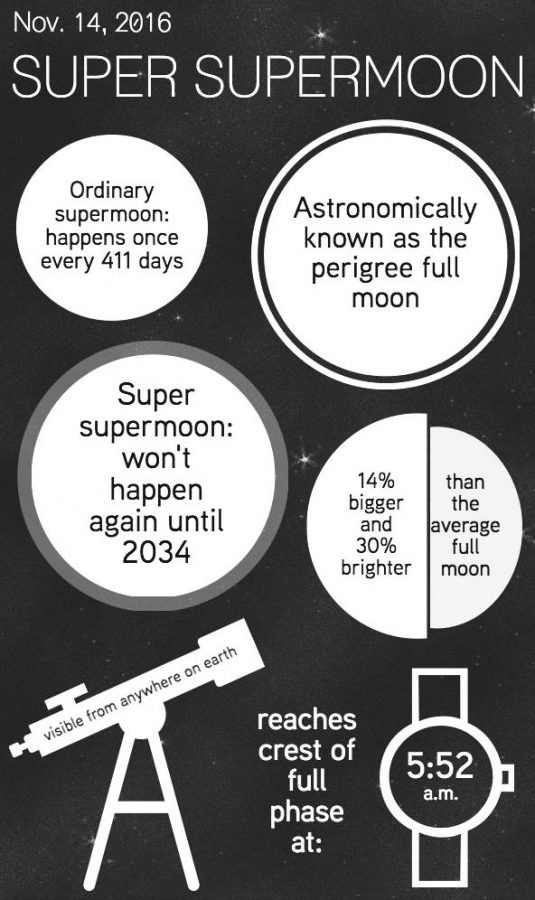Perigee Supermoon lights up the sky after 68 years
While full moons occur once every month, supermoons- characterized by their larger-than-average size and their remarkable brightness- light up the night sky only once every 411 days. “It’s fun to go outside and look at the moon when it’s bigger, and it also will look brighter as a result,” Dr. Nelson said. “Not just as an appearance, but it actually will be brighter than your average full moon.”
November 18, 2016
Every 29.5 days, the full moon shines in the night sky, illuminating the darkness with its glow. While astronomer and casual observers alike have many opportunities to study the moon at its fullest, tonight’s night sky features something unique- something astronomers call the supermoon.
The word “supermoon” refers to a full moon that is larger than average. Tonight’s moon will be especially large because the moon is full at its perigee, the point at which it is closest to Earth in its ellipse-shaped orbit. The last time the moon was this close to the Earth was in 1948. Astronomers speculate that this year’s supermoon will be 14 percent larger and 30 percent brighter than when the moon is at apogee, it’s furthest point from earth.
The moon will reach the crest of its full phase at 5:52 a.m. and will reach perigee within 1.5 hours of the crest.
The phrase “supermoon” was previously used to only refer to this type of moon, but it has evolved into a looser term merely referring to size, so a perigee supermoon will often be referred to as an “extreme” supermoon. Supermoons occur about once every 411 days.
“[Supermoons] are actually pretty common,” astronomy teacher Dr. Eric Nelson said. “But this one, in terms of the terminology we use for supermoons, is unusual because it is so close to the actual perigee position rather than just being closer than the mean.”
Tonight’s moon will be visible anywhere on Earth where it is dark and relatively cloudless.
Jimmy Lin (11) did an astrophysics research internship at University of California, Santa Cruz in the summer of 2015.
“I think it’s definitely great that this new story is helping astronomy reach the general public, and I think it’s a great opportunity for the common person to get interested in a national phenomenon that also has a scientific understanding behind it,” he said.
Sneha Bhethanabotla (12) has an interest in astronomy and is aware of the supermoon phenomenon.
“I wish the school would organize an event to view supermoons. Not a lot of people have the time to see it, so if there’s a school organized event it would be cool,” Sneha said. “More people would see something pretty.”
Although supermoons as large as the one that was visible are relatively uncommon, supermoons in general occur relatively often. The next supermoon will occur on Dec. 14.
Observers who miss either of these supermoons will have many opportunities in the near future to witness other astronomical events. The next lunar eclipse, or the passing of the Moon into the Earth’s shadow, will occur on Feb. 11 of next year and will be visible in North America, although it will be a partial eclipse.
The next solar eclipse, or the passing or the Moon between the Sun and the Earth, will occur Feb. 26, although the next solar eclipse easily visible from North America will occur Aug. 17 of next year and will be a total eclipse.
This piece was originally published in the pages of The Winged Post on November 16, 2016.


















![“[Building nerf blasters] became this outlet of creativity for me that hasn't been matched by anything else. The process [of] making a build complete to your desire is such a painstakingly difficult process, but I've had to learn from [the skills needed from] soldering to proper painting. There's so many different options for everything, if you think about it, it exists. The best part is [that] if it doesn't exist, you can build it yourself," Ishaan Parate said.](https://harkeraquila.com/wp-content/uploads/2022/08/DSC_8149-900x604.jpg)




![“When I came into high school, I was ready to be a follower. But DECA was a game changer for me. It helped me overcome my fear of public speaking, and it's played such a major role in who I've become today. To be able to successfully lead a chapter of 150 students, an officer team and be one of the upperclassmen I once really admired is something I'm [really] proud of,” Anvitha Tummala ('21) said.](https://harkeraquila.com/wp-content/uploads/2021/07/Screen-Shot-2021-07-25-at-9.50.05-AM-900x594.png)







![“I think getting up in the morning and having a sense of purpose [is exciting]. I think without a certain amount of drive, life is kind of obsolete and mundane, and I think having that every single day is what makes each day unique and kind of makes life exciting,” Neymika Jain (12) said.](https://harkeraquila.com/wp-content/uploads/2017/06/Screen-Shot-2017-06-03-at-4.54.16-PM.png)








![“My slogan is ‘slow feet, don’t eat, and I’m hungry.’ You need to run fast to get where you are–you aren't going to get those championships if you aren't fast,” Angel Cervantes (12) said. “I want to do well in school on my tests and in track and win championships for my team. I live by that, [and] I can do that anywhere: in the classroom or on the field.”](https://harkeraquila.com/wp-content/uploads/2018/06/DSC5146-900x601.jpg)
![“[Volleyball has] taught me how to fall correctly, and another thing it taught is that you don’t have to be the best at something to be good at it. If you just hit the ball in a smart way, then it still scores points and you’re good at it. You could be a background player and still make a much bigger impact on the team than you would think,” Anya Gert (’20) said.](https://harkeraquila.com/wp-content/uploads/2020/06/AnnaGert_JinTuan_HoHPhotoEdited-600x900.jpeg)

![“I'm not nearly there yet, but [my confidence has] definitely been getting better since I was pretty shy and timid coming into Harker my freshman year. I know that there's a lot of people that are really confident in what they do, and I really admire them. Everyone's so driven and that has really pushed me to kind of try to find my own place in high school and be more confident,” Alyssa Huang (’20) said.](https://harkeraquila.com/wp-content/uploads/2020/06/AlyssaHuang_EmilyChen_HoHPhoto-900x749.jpeg)










